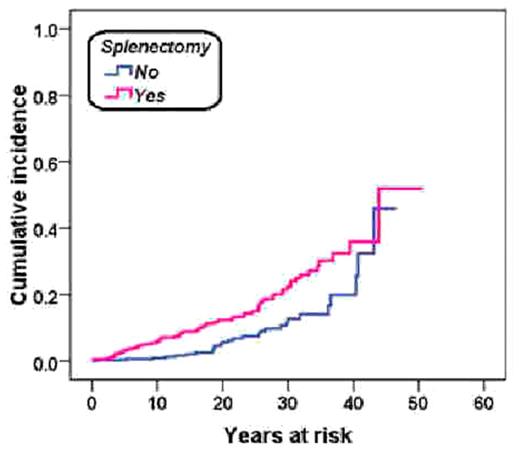Abstract
The use of splenectomy for thalassemia major (TM) is restricted over concerns of its long-term outcome. The aim of this retrospective cohort study was to assess the incidence of cardiac complications (CC) in a large multicentric cohort of splenectomized TM patients.
We considered 360 TM patients (177 males, mean age 36.59±7.11 years) who performed the splenectomy between 1966 and 2010 (mean age at splenectomy 13.75±8.06 years) and an equal number of TM patients with the spleen, matched by age and sex. Both groups of patients were consecutively enrolled in the Myocardial Iron Overload in Thalssemia (MIOT) Network and were followed-up until October 2016. For each splenectomized patient, the years at risk were calculated from the date of splenectomy until the date of completion of the study, death, or diagnosis of a CC, whichever occurred first. For each non-splenectomized patient the same time at risk of the correspondent splenectomized patient was used. In case of death or CC, the time at risk was the difference between the date of death or CC and the date of transplantation of the matched patient. The cumulative incidence was used to assess the absolute risk of CC over different periods of time.
Among the splenectomized patients, 62 CC were recorded (32 arrhythmias, 25 heart failure, 4 pulmonary hyperthension, and 2 thromboembolic events). The cumulative incidence of CC was 5.79% at 10 years from splenectomy, 12.29% at 20 years from splenectomy, 22.42% at 30 years from splenectomy, and 35.95% at 40 years from splenectomy.
Among the TM patients with the spleen, 28 CC were recorded (8 supraventricular, arrhythmias, 14 heart failure, 3 pulmonary hyperthension, and 3 thromboembolic events). In this cohort of patients, the cumulative incidence of CC was 0.92% after 10 years, 5.68% after 20 years, 12.78% after 30 years, and 25.65% after 40 years.
The cumulative incidence of CC in both groups is shown in the figure: it was higher in splenectomized patients, with a statistically significant difference (P=0.0008).
In conclusion, in the present study we showed for the first time that thalassemic splenectomized patients had a significant higher incidence of cardiac complications. The pathophysiologic mechanisms are multiple: splenectomy leads to increased platelet activation and red cell microparticles, upregulating vascular adhesion molecules and promoting thrombosis, causes increased scavenging of nitric oxide contributing to pulmonary vasculopathy and development of pulmonary hypertension, and predisposes patients to infections increasing the risk of myocarditis that can result in heart failure and arrhythmia.
Pepe: Chiesi Farmaceutici and ApoPharma Inc.: Other: Alessia Pepe is the PI of the MIOT project, that receives no profit support from Chiesi Farmaceutici S.p.A. and ApoPharma Inc.
Author notes
Asterisk with author names denotes non-ASH members.


